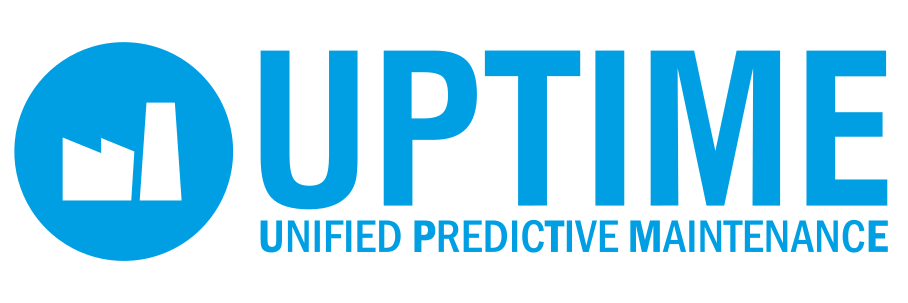0
26.06.2020
Dear reader,
Welcome to the 6th edition of the UPTIME Newsletter. First of all, we hope that you and your loved ones are staying safe and healthy during these challenging times.
The UPTIME project has entered the evaluation phase. The prototype of the UPTIME Platform has been integrated into the three industrial business cases in its final configuration. In this edition, MAILLIS shares with us their first-hand experience and some lessons learned from the recent implementation of the UPTIME Platform in the MAILLIS Business Case, which deals with predictive maintenance in a cold rolling mill for the production of steel strapping.
In the previous newsletters, we introduced five of the UPTIME Platform’s main components. In this issue, we’ll present the last component prototype, UPTIME_VISUALIZE, which provides individual, customizable and configurable visualisation of data in a customer-oriented way. Its implementation in the MAILLIS Business Case is used as an example of how it works.
We have also been organising a series of webinars showcasing the main features of the UPTIME Platform including live demonstrations of their implementation in our industrial use cases. The first webinar on the implementation in the White Goods case was held on 19 March 2020. In case you missed it, you can find the webinar recording here.
The second webinar, “UPTIME Predictive Maintenance: Lessons Learned and Best Practices in the Steel Industry“, will take place on Thursday, 09 July 2020, 11:00 – 12:30 CEST. We hope you can join our webinar and look forward to interacting with you and getting your valuable feedback. To register and get more detailed information about the webinar, please click here.
We hope you enjoy our newsletter!


The UPTIME Platform consists of six main components, addressing various phases of the unified predictive maintenance approach. In our previous newsletters, we introduced UPTIME_SENSE for data acquisition and manipulation, UPTIME_DETECT & _PREDICT for stream data analytics, UPTIME_DECIDE for maintenance decision-making and action planning, UPTIME_ANALYZE for batch data analytics and UPTIME_FMECA for risk assessment. In this edition, we present the last component UPTIME_VISUALIZE for visual analytics.
The UPTIME Platform is a unified platform with end-to-end integration and communication among its functional parts. UPTIME_VISUALIZE is a Human-Machine Interface, which visualizes data in the appropriate, customer-oriented way and allows the user to monitor and interact with the data in real time as well as in an offline mode for detailed batch data analysis.
UPTIME_VISUALIZE mainly deals with the definition, extension and implementation of data aggregation and visualization. It provides individual, customizable and configurable visualisation (dashboard) to save time analysing data and getting insights, to support decision-making and develop new solutions.
Key advantages of UPTIME_VISUALIZE include:
◦ Save time analyzing data and getting insights through role- and user-oriented simple/complex representation
◦ Ability to share info & insights with different domains
◦ Reduced time to draw conclusions from data representation and take action
◦ Location-independent monitoring of status and reaction to events
Currently, machine maintenance and monitoring in the MAILLIS business case is done by visual inspection and based on the engineer’s judgement.
One of the main aims of UPTIME_VISUALIZE data visualization is to provide optimum maintenance times by inspecting the status of the rollers and bearings through sensors attached to the rollers. This is crucial since, during operation, there is no way to know the conditions inside the milling stations; acoustic or visual cues of abnormal operation usually come too late after a significant amount of damage has been done to the roller (e.g. jamming, roller breaks) or in the bearings.
For the MAILLIS business case, data about velocity and acceleration at the roller are collected and visualized, for example, as shown in following figure. In addition, a Shock Finder Indicator is implemented to provide reliable data even in low speed operation.
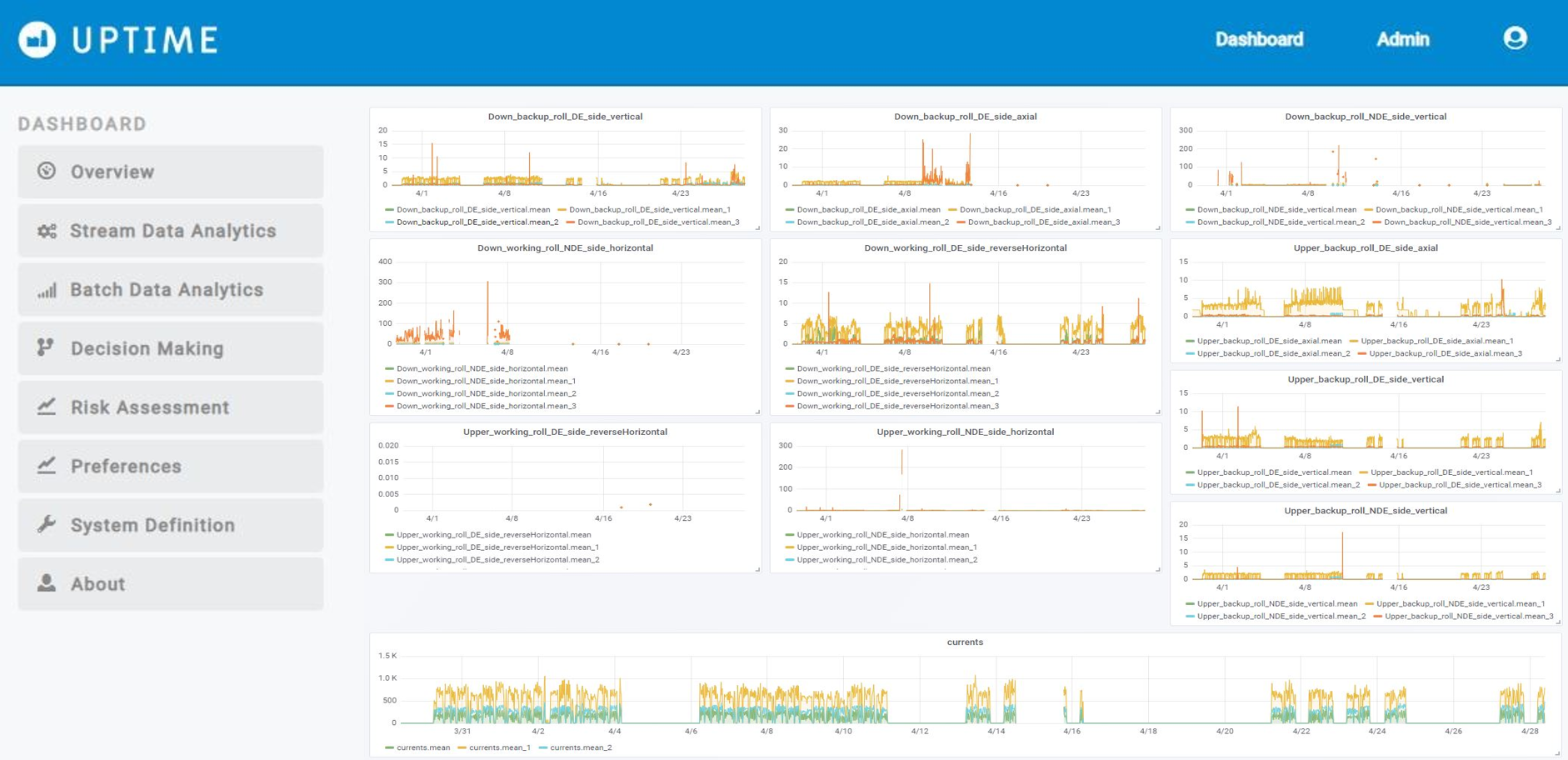
The maintenance staff can easily monitor data coming from different sensors at different places of the rollers and the motor of the milling station. The time span visualized is the same in all graphs, regardless of real time or batch data. This allows for a quick correlation of sensor data streams and the identification of areas that can have a significant impact. Decisions on an early inspection outside of the usual maintenance cycle times can be made right away. These decision can of course be supported by the other UPTIME Platform components already described in previous newsletters.
If you are interested in potentially deploying UPTIME_VISUALIZE in your context, please feel free to contact us!

Implementation of UPTIME Platform in the MAILLIS Business Case
The UPTIME Platform is deployed in and validated against three industrial use cases: (1) production and logistics systems in the aviation sector, (2) white goods production line and (3) cold rolling for steel straps.
In this 6th edition, we interview the UPTIME project partners responsible for the MAILLIS cold rolling business case: Vasilis Boursinos, General Manager, and Efstathios Anastasiou, Head of Production of M.J. Maillis S.A. Industrial Packaging Systems and Technologies as well as Dimitris Ntalaperas, Software Architect at Ubitech.
During the interview, they share with us their first-hand experience and some lessons learned from the recent implementation of the UPTIME Platform in the MAILLIS Business Case. With UPTIME having entered the evaluation phase, MAILLIS can reflect upon the results already achieved, the challenges that need to be overcome and how these results, upon successful evaluation, can become part of the MAILLIS Modus Operandi.
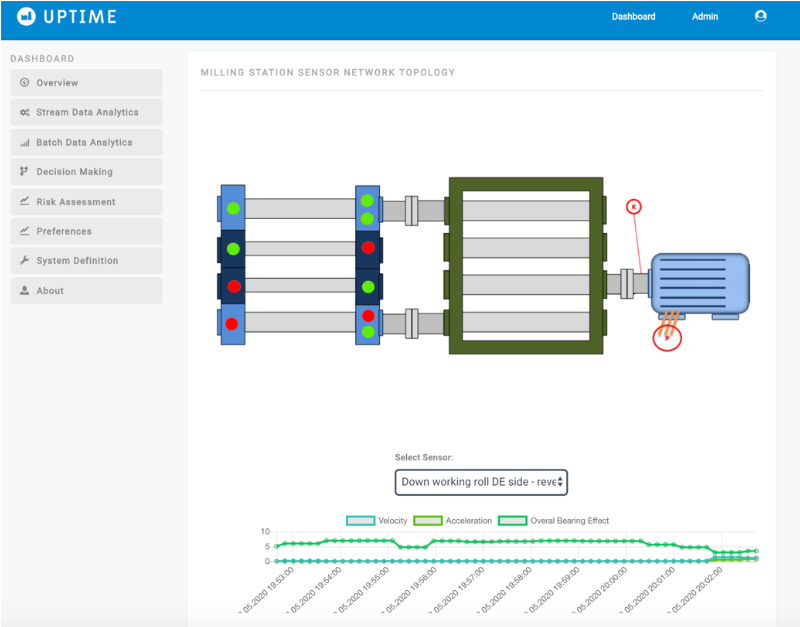
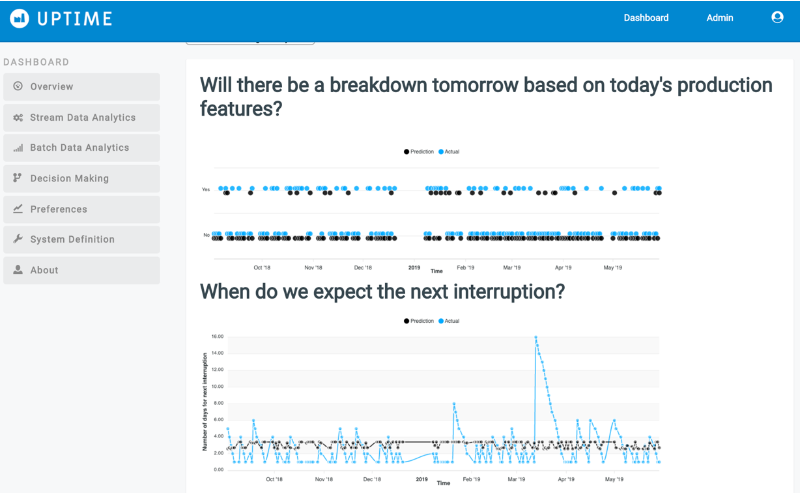
What have been achieved so far after the implementation phase of the UPTIME Platform in the MAILLIS Case?
Advancements in most areas covering the operations of MAILLIS have been observed by incorporating the UPTIME solution. Though not exhaustive, the list of the main advancements in terms of impact can be summarized as follows:
● Monitoring and prediction of shocks
Using UPTIME_SENSE, MAILLIS can now be alerted for the presence of shocks, a task that was very difficult to perform with visual or acoustic inspection before UPTIME. This is partly due to the extreme physical conditions present in the milling station.
Incorporating UPTIME_DETECT_PREDICT has also helped predict future shocks, thereby facilitating preventative actions to be conducted by MAILLIS staff.
●Monitoring and prediction of defects in bearings
In the same manner, MAILLIS can detect and predict a potential galling occurring in the bearing contact surfaces by utilising special sensor infrastructure that can monitor the galling both during the initial formation and as this develops.
● Incorporation of new maintenance strategies
Using UPTIME_DECIDE, forecasts concerning shocks and bearing defects generate suggestions of custom maintenance actions. These can be integrated into new maintenance plans that, as a whole, reduce downtime and overall maintenance cost.
●Estimation of roller operational time and future damage probability
By combining UPTIME_DETECT_PREDICT with UPTIME_ANALYZE and deep learning techniques, MAILLIS can now combine maintenance and Overall Equipment Efficiency (OEE) data with streaming data from sensors and obtain estimations of the Remaining Useful Life for each roller. Furthermore, the presence of future roller defects (e.g. marks) can also be predicted with good accuracy.
● Risk estimation
By using UPTIME_FMECA, MAILLIS can have at any time an overview of the criticality of any one of the components that comprise the milling station.
What are the main challenges in the implementation phase and some lessons learned so far?
In order to achieve the results, various obstacles, both foreseen and unforeseen, need to be overcome. The main challenges, in terms of effort spent, include:
● Finding reliable technical service providers and equipment suppliers. Intensive participation and involvement of the Procurement Department are strongly required, in close cooperation with the Financial Department.
● The requirement for extensive engagement in the exploitation of the data obtained and the application of the results to the industrial process. We often face the need to review not only the design of the necessary equipment but also the type and amount of data to be collected.
● The efficient cooperation of the employees involved in the project. That cannot always be achieved without interruptions due to the nature of such project, which is common to many Industry 4.0-related endeavours.
● Technical difficulties in installing and maintaining the sensor network itself. The extreme physical conditions present in the milling station cause damage to the sensors. Custom installation and placement techniques need to be devised to overcome this problem.
Our experience from the project so far makes us quite optimistic about the remaining steps; it also encourages us to continue the effort to improve the way we collect and exploit the data we receive.
What are the next steps for the MAILLIS Business Case?
The next step involves the evaluation of our achievements in terms of production-related KPIs. More specifically, overall maintenance cost, overall downtime and overall production output will be measured and compared both to past data and to control data gathered from other milling stations, in which UPTIME has not yet been implemented.
After a positive evaluation, we plan to implement the program in different processes, i.e. applying the UPTIME solution in other Maillis’ Group production sites.
In the upcoming UPTIME Webinar, Efstathios Anastasiou and Dimitris Ntalaperas will speak about UPTIME predictive maintenance in the steel industry and the implementation of UPTIME Platform in more details. If you are interested, please feel free to register here.

M.J. Maillis S.A.



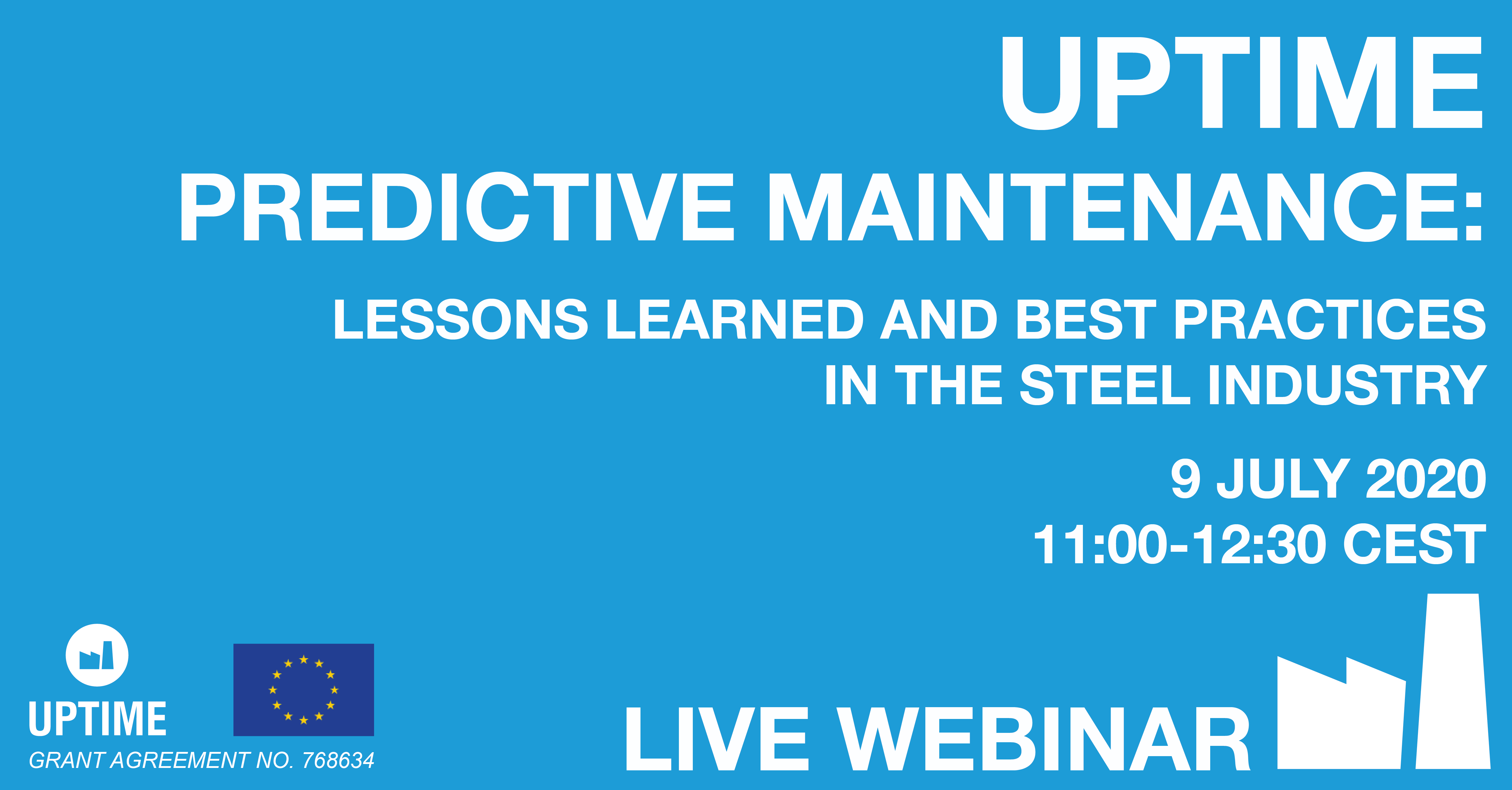
UPTIME 2nd Webinar “Predictive Maintenance: Lessons Learned & Best Practices in the Steel Industry” will be held on 9 July 2020, from 11:00 to 12:30 CEST. We are eager to have the opportunity to present you the UPTIME Predictive Maintenance Platform and the implementation in the MAILLIS business case.
This webinar is free of charge and dedicated to people who want to learn and see a concrete implementation of our Predictive Maintenance Platform in a real business case. The webinar will be interactive, where you will have the opportunity to get your questions answered by our experts panel, and we will be happy to receive your feedback. For more details about the webinar, please visit here. If you have any questions or comments, please contact us.
During the 1st UPTIME live webinar “Lessons learned and best practices in White Goods Industry”, on 19 March 2020, we shared our views and experiences with close to 30 stakeholders about the differences between traditional preventive maintenance and predictive maintenance using historical data and real time data.
The experiences we shared were based on the implementation of the UPTIME Platform at a Whirlpool factory in a complex automatic production line, which produces drums for clothes dryers.
A full article elaborating the main insights of the lessons we learned and the main feedback received from the audience, as well as the webinar recording, are available in the UPTIME Website.
The ForeSee Cluster is organising an invited session: “Versatile predictive maintenance strategies for the industry of the future” at the 4th IFAC Workshop on Advanced Maintenance Engineering, Services and Technologies from 10-11 Sept 2020. The workshop will be held online.
The ForeSee cluster consists of six projects, including UPTIME, which conduct research into different aspects of Predictive Maintenance. More than 80 organisations are involved in total, contributing to a large number of industrial pilots. This session aims to bring together key partners from each project to allow for knowledge exchange and the sharing of experience, as well as guiding the agenda for future research on Predictive Maintenance. For further information, please visit AMEST 2020.
10 – 11 Sept 2020
Online
